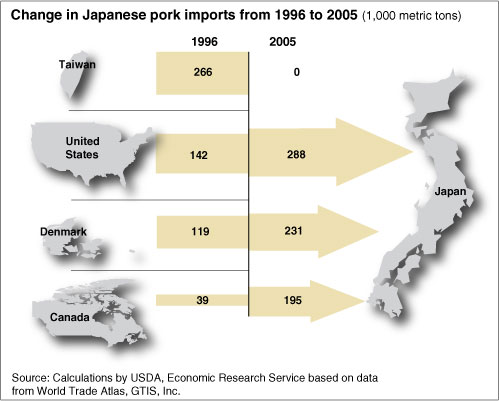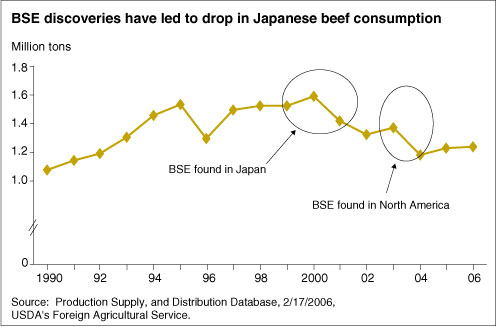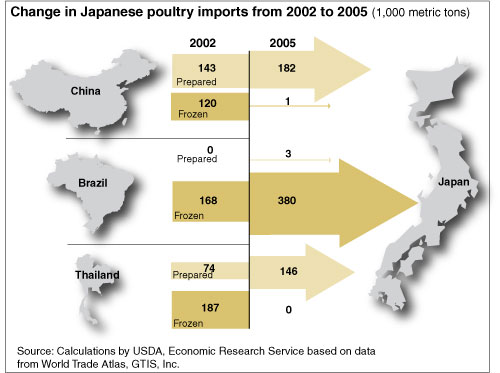Economic Effects of Animal Diseases Linked to Trade Dependency
- by Donald Blayney, John Dyck and David Harvey
- 4/1/2006
Highlights
- Global levels of meat trade have not declined despite the last decade’s high-profile bans on meat trade flows.
- The economic effects of disease-related trade bans on an individual country depend on the size of its livestock trade relative to domestic consumption. The most severe im-pacts have been felt in a few export-dependent markets and in those import-dependent markets where substitutes for banned trade were not found.
- The economic significance of animal disease outbreaks is also influenced by consumer response: Fears that the disease can spread to humans can lead to sharp drops in consumption.
The importance of livestock and poultry trade to producers and consumers around the world increased in the last part of the 20th century. Producers in major exporting countries grew to rely on trade as a significant outlet for their products, and consumers in the importing countries relied increasingly on trade for a significant contribution to their diets.
In the last decade, however, a spate of animal disease outbreaks has repeatedly disrupted livestock and poultry meat trade and created uncertainty about future trade disruptions. Two diseases, avian influenza (AI) and bovine spongiform encephalopathy (BSE), are at the forefront of today’s trade disruptions, but a third disease, foot-and-mouth disease (FMD), has caused havoc in livestock markets for the past decade and emerged again very recently in Brazil. Some of the trade disruptions have resulted in losses for livestock industries, such as the pork exporters of Taiwan, whose exports were nearly eliminated from early 1997 to the present because of FMD. Disease-related interruptions of trade flows have also affected the food industry and consumers in the importing countries, when the meat affected by the ban could not be replaced by either domestic producers or other exporting countries or when consumers reduced purchases because of fears for their health.
The economic costs of these disruptions vary, and three criteria help explain the extent of damage done by a disease outbreak. First is the relative importance of meat exports to producers in the affected country. Loss of export markets is much more serious if 40 percent of the country’s output is exported than if 5 percent is exported. For example, disease outbreaks among the pork industries in Denmark and Taiwan and the poultry industry in Thailand, all heavily dependent on exports, have inflicted great damage on producers in those countries. A sudden end to trade leaves an increased supply of meat that must be sold domestically, reducing prices. In contrast, a large country like China has suffered less disruption from AI because it was less dependent on poultry exports.
Second is the relative importance of imports from an affected country to consumers in an importing country. If a country affected by disease supplies 20 percent of an importing country’s meat, a sudden end to the imports can lead to a fall in consumption unless domestic production or imports from another country can make up the deficit. For example, after the AI outbreaks in China and Southeast Asia, Japan was able to partially replace poultry imports from Asia with imports from Brazil. In contrast, Japan’s beef imports from the U.S. were not so easily replaced.
The final factor is whether the animal disease poses a threat to humans, because consumers’ fears can reduce consumption. FMD and highly pathogenic AI are both contagious viral infections in animals and birds that cannot be contained easily. BSE is a different kind of disease—it is not contagious and does not spread rapidly. FMD does not typically affect humans, but the highly pathogenic H5N1 strain of AI appears to have been transmitted to humans through very close contact with infected birds. Cooking kills the viral agents of FMD and AI in meat but not the BSE agents. BSE is thought to cause a fatal brain disease in humans who eat high-risk tissue from infected animals.
A Decade of FMD Shocks Brings an End to Taiwanese Pork Exports
FMD is a very contagious viral infection that can cause death or permanent disability for cattle and swine and can spread very rapidly in a number of different ways. Beef and pork trade flows have long been defined by the identification of “FMD-free” and “FMD” zones. For much of the 20th century, the FMD-free zone was a stable group of countries or territories including the U.S., Canada, Australia, New Zealand, Japan, South Korea, Taiwan, and, sometimes, Denmark. Because these countries recognized each other as free of FMD, sanitary barriers did not ordinarily inhibit trade among them or affect their exports to countries that were not FMD-free. Countries not recognized as FMD-free can export only cooked meats, such as corned beef or canned hams (cooking kills the virus), to the FMD-free zone, not chilled or frozen meat. The strict enforcement of FMD trade restrictions reflects the efforts that went into eradicating the disease in places where it was done successfully. Japan’s eradication in 1907, and the eradications in Taiwan and the U.S. in the 1920s, required massive campaigns. Reportedly, all hogs on the island of Taiwan were destroyed, an action that made the island FMD-free for the next 50 years. The stability of the FMD-free zone ended in the latter half of the 1990s.
Trade in beef and pork (and live cattle and swine), both within the disease-free zones and among countries that had not yet achieved FMD-free status, was shaken by events beginning in 1997. FMD began to spread widely around the world, and Taiwan experienced an outbreak in that year so severe that more than a third of the island’s hogs (4 million of the 11 million on the island) died or were slaughtered and the carcasses destroyed, not eaten. Dependence on exports was high, with 40 percent of output going to Japan. A decade later, despite efforts to recover FMD-free status and regain its once-large export presence, Taiwan has a much smaller hog population and lower exports. Exports from Taiwan made up 40 percent of Japan’s pork imports, but that loss was offset by rising imports from Canada, Denmark, and the U.S., as well as greater-than-expected production within Japan itself. Pork from Taiwan had distinct appeal in Japan’s market, but was not so differentiated that it could not be replaced.
Over the next 5 years, smaller outbreaks occurred in Japan and South Korea (both FMD-free for many decades) and a large outbreak swept parts of Western Europe, which had long struggled to become FMD-free. In South America, Argentina and Brazil had been working hard to achieve FMD-free status, but experienced outbreaks after 2000. The stability of the FMD-free zone from about 1930 to 1997 has given way to volatility caused by the outbreaks of the last decade, and renewed fear among producers in all the exporting countries.
In the past, FMD outbreaks typically resulted in bans on imports from anywhere in affected countries. However, over the last two decades, in order to help mitigate the drastic consequences of whole-country bans, importing countries have sometimes agreed to restrict their trade bans to those regions within the country where the outbreak occurred, allowing imports from other regions that are disease free, a practice known as regionalization.
BSE Perceptions Affect Consumers in Japan and Korea More Than U.S. Producers
Unlike FMD, the discoveries of BSE in cattle have caused widespread concern about the safety of beef consumption in some markets. BSE, also called mad cow disease, is a neurological disease in cattle that was first discovered in Britain in 1986. It was thought to affect only cattle until 1996, when the British Government announced a possible link to a new human variant of Creutzfeldt-Jacob Disease, and BSE was elevated from an animal health concern to a human health concern. Unlike viral diseases, such as AI and FMD, scientific research indicates that cooking does not kill the causal agent of BSE. But, with measures in place to remove the significant risk materials from the food system, human health risks from BSE are minimized.
The Canadian Government announced the discovery of the first case of BSE in a North American-born animal, a beef cow in Alberta, in May 2003. All of the country’s major trading partners, including the U.S., banned imports of Canadian beef and live cattle immediately. In August, the U.S. allowed boneless beef from cattle under 30 months of age, but not live cattle, to be imported from Canada. Then, in December 2003, discovery of a BSE-infected cow in Washington State led some 70 countries, including Canada and Mexico, to impose import bans of varying degrees on U.S. beef and cattle. U.S. beef exports dropped from a record 2.5 billion pounds in 2003 to 461 million pounds in 2004, a fall of over 80 percent. The bans on U.S. beef exports clearly were significant to U.S. exporters and to the consumers of U.S. high-quality, grain-fed beef in countries such as Japan, Korea, and Hong Kong, whose markets were closed to the U.S. and where beef prices rose. While the U.S. beef industry depended on exports to take 9-10 percent of output, the domestic market was strong and absorbed the increase in supply.
The U.S. ban on Canadian beef imports in May 2003 came at a time when U.S. beef supplies were already tight, and the ban led to even tighter supplies. By October 2003, the supply situation had generated record-high U.S. cattle and beef prices. Domestic beef production was declining because producers had been reducing inventories since 1996, while the demand for high-quality, grain-fed beef remained high. With the domestic market fetching high prices, the beef industry was better able to absorb losses in export revenue. In addition, U.S. meat consumers did not abandon eating beef after the BSE discoveries as consumers in Europe and Japan had done, at least for limited periods. Japan’s annual consumption of beef dropped by about 15 percent in 2001, when BSE was discovered in Japan.
Japanese and Korean consumption of beef fell even more when U.S. beef was cut off. The two Asian markets depended heavily on North American, especially U.S., beef. North American beef constituted one-fourth of total Japanese consumption in 2002. Furthermore, beef trade was concentrated on a few cuts of beef, particularly short plate and short ribs. Japanese and Korean restaurants had developed a strong demand for dishes made with these cuts. No other BSE-free beef supply in the world was big enough to replace the U.S. supply of these cuts. Japanese and Korean consumers also liked the taste of grain-fed beef from North America. Beef from Australia and New Zealand has traditionally been grass fed, and attempts to feed grain to the degree that it is fed in North America have not been viable on a large scale. Most North American beef has not been replaced in the two Asian markets. Japan’s beef consumption in 2004 was 25 percent below 2000 levels because of the combined effect of drops in demand and reduced supply.
Asian Poultry Markets Disrupted by Avian Influenza
Well-publicized outbreaks of the highly pathogenic H5N1 strain of AI began in Asia in 1998. The strain was first identified in Hong Kong, where it killed several people. In response, the entire poultry population in Hong Kong—millions of birds—was slaughtered to eradicate the disease. However, in 2001, H5N1 reappeared in China, and in 2003 and 2004, it affected several poultry populations in Southeast Asia. In 2005, it spread across Asia and reached Europe; cases were reported in Europe and Africa in early 2006. Highly pathogenic strains of AI are very dangerous to birds, spreading quickly and often killing the birds. The H5N1 strain has also spread from birds to people when people have been in close contact with diseased birds.
Like FMD, AI viruses in meat are killed by cooking. Unlike FMD, however, H5N1 can infect and kill humans from bird-to-human contact. Medical experts worry about a possible human pandemic if the H5N1 variant mutates in ways that make transmission of the virus directly between people easier. This worry has led to extra efforts to eradicate AI, such as killing or banning all live chickens and other birds in major Asian cities—examples include Hong Kong and cities in Vietnam—and to campaigns to vaccinate entire populations of various species of birds against H5N1 AI.
Trade disruptions from H5N1 AI affected two of the world’s major exporters of chicken meat, Thailand and China. Thailand’s broiler industry depends heavily on exports and was hard-hit by the bans. China’s exports are a small share of its chicken meat output, and the impact of bans on its exports was less significant nationally, although severe for producers focused primarily on the Japanese market.
Consumer concerns about the safety of poultry in certain markets—e.g., Japan, China, Vietnam, and Thailand—led to sudden drops in consumption, although cooked chicken meat and egg products are safe to eat. But even though Japan is dependent on imports for a large share of consumption, the AI outbreaks in China and Thailand have not negatively affected supplies in Japan. Brazil has greatly expanded its exports to Japan, and China and Thailand have transformed their exports into heat-treated products that to some extent replace earlier frozen exports (see “Asian Markets Restructured by AI”).
Animal Diseases Are a Continuing Threat
Meat sectors in a number of countries have suffered serious damage from disease outbreaks. On a global scale, however, trade disruption by and consumer reaction to fears of infectious animal diseases are not readily apparent (see “Effects of AI on U.S. Poultry Industry So Far Are Minimal”). Global production, consumption, and trade of pork and broiler meat have continued to grow through the animal disease episodes of the last decade, and global beef production and consumption have stayed relatively constant since 1990. In most cases, disease-related import bans have been mitigated by increasing supplies from domestic or alternative foreign sources of meat. Similarly, global feed use of corn has continued to rise, despite drops in annual corn use as high as 25 percent in certain countries (Thailand from 2001 to 2003, Taiwan from 1996 to 1998).
Meat trade increasingly requires that a supply chain for meat can be identified that both the importing and exporting countries agree poses low risk of disease transmission. Elements of this risk-based decisionmaking have been adopted by the World Organization for Animal Health for BSE and AI and in recent agreements among countries affected by BSE (e.g., Japan, Canada, and the U.S.). It may lead to a reduction in the extent and duration of trade bans. Technological advances in identifying disease strains and in tracing the origin of meats and the increasing use of risk analysis offer hope that outbreaks may be avoided or contained more quickly. Animal diseases, however, remain volatile threats to global trade in meats.
This article is drawn from:
- Blayney, D. (2005). Disease-Related Trade Restrictions Shaped Animal Product Markets in 2004 and Stamp Imprints on 2005 Forecasts. U.S. Department of Agriculture, Economic Research Service. LDPM-13301.
- Livestock, Dairy, and Poultry Outlook. (2006). USDA, Economic Research Service. coordinated by Mildred Haley, LDP-M-140..
- Livestock, Dairy, and Poultry Outlook. (2006). USDA, Economic Research Service. coordinated by Mildred Haley, LDP-M-139..
You may also like:
- Japan & South Korea. (n.d.). U.S. Department of Agriculture, Economic Research Service.
- Animal Policy & Regulatory Issues. (n.d.). U.S. Department of Agriculture, Economic Research Service.




